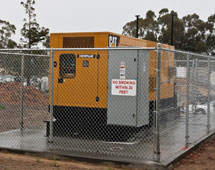
Handy Links
SLAC News Center
SLAC Today
- Subscribe
- Archives: Feb 2006-May 20, 2011
- Archives: May 23, 2011 and later
- Submit Feedback or Story Ideas
- About SLAC Today
SLAC News
Lab News
- Interactions
- Lightsources.org
- ILC NewsLine
- Int'l Science Grid This Week
- Fermilab Today
- Berkeley Lab News
- @brookhaven TODAY
- DOE Pulse
- CERN Courier
- DESY inForm
- US / LHC
SLAC Links
- Emergency
- Safety
- Policy Repository
- Site Entry Form

- Site Maps
- M & O Review
- Computing Status & Calendar
- SLAC Colloquium
- SLACspeak
- SLACspace
- SLAC Logo
- Café Menu
- Flea Market
- Web E-mail
- Marguerite Shuttle
- Discount Commuter Passes
-
Award Reporting Form
- SPIRES
- SciDoc
- Activity Groups
- Library
Stanford
Around the Bay
Computer Services Completes Core Infrastructure Upgrade
The recent refurbishing of Substation 8 may have happened with a minimum of impact to computer users around SLAC, but it marks a big milestone for the Computing Division's IT Operations and Infrastructure group, said Norm Ringgold, who leads the team. For the past 18 months, the group has been making big gains in what Ringgold called "core computing infrastructure" at Building 50—data center space to house computers, electricity to power them and the chilled water to keep them cool.
"Our total data center includes around 17,000 square feet of space," Ringgold said. "The recent removal of six old tape silos"—in addition to other, smaller clean-up projects—"gives us easily over 3300 square feet of open expansion space in Building 50 to accommodate several planned scientific computing projects."
Power capacity has been increased to 3.6 megawatts from the 2.0 megawatts available 18 months ago, and cooling capacity has been significantly increased as well, Ringgold said. "I estimate that we have at least 30 percent additional cooling capacity in the building over current demand." But the improvements go far beyond a simple "more is better" mindset.
"We've made big improvements in core infrastructure resiliency," Ringgold explained—in other words, working closely with Boris Ilinets, an electrical engineer from Facilities who is a dedicated resource for Computing, Ringgold's team has implemented a series of measures to keep SLAC computers up and running even if the power goes out. Two uninterruptible power sources—essentially batteries—stand between essential Building 50 servers and their external power source. Should power be interrupted, the batteries would take over immediately. Backing up the batteries is a 500 kilowatt generator with a full 490-gallon fuel tank. "The generator spins up and provides peak power within 15 seconds" of the initial outage, and can run at full capacity for 24 hours on a single tank of fuel, Ringgold said.
"Overall, this sends a very good message of appropriate planning and available core capacity in Building 50 for the next two-and-a-half years," he continued, "but having the capacity is only half the battle." Ringgold said he hopes to work more closely with the various scientific leaders around SLAC so that the extra space and capacity is put to best use.
"In my opinion one of our next steps will be to connect the future plans of scientific computing with our own data center field-delivery funding and schedule, so we can better accommodate their future growth plans," Ringgold said. "This way, IT Operations could develop an overall data center design and plan that takes all scientific computing and business systems additions into account. This will enable us to complete required infrastructure changes prior to when they're needed. This will also result in an ability to implement new computing acquisitions immediately upon delivery, rather than several months afterwards."
—Lori Ann White
SLAC Today, May 19, 2011
